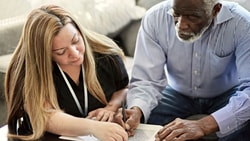3 Steps to Improve Executive Cognitive Function Following TBI
November 23, 2016
3 min. read

We all want successful community integration following traumatic brain injury (TBI). Yet, wanting it and accomplishing it are often two very different things.
Working with individuals following TBI, we often see clients struggling with skills essential to working, school, or building/maintaining relationships, such as:
Solving problems
Making decisions
Controlling emotions
Organizing things
Initiating tasks
Helping our clients overcome higher-level cognitive deficits that impact community participation is essential to a successful rehabilitation outcome.
Why Focus on Executive Cognitive Functions?
Executive cognitive functions are among the strongest predictors of successful long-term functional outcomes.3,9 These higher order cognitive skills tend to be lesser known to rehabilitation professionals compared to other aspects of cognition like attention, concentration, and memory, but they greatly contribute to adult role performance.
Three Key Changes
If you work with executive function deficits following TBI, you must commit to learning how these cognitive operations impact human behavior. You will also need to be flexible, yet systematic, in your approach to rehabilitation.
Beyond having knowledge, patience, and tolerance, therapists should help patients implement three changes:
1. Encourage Self-Awareness
The treatment of most executive cognitive functions begins by encouraging self-awareness of deficits. Without realizing how impairments impact performance, a client may be reluctant to collaborate with therapists on a plan of improvement.
For example, it is difficult for the therapist to work on an anger management program or problem-solving strategies with a client who doesnt feel like they have these problems.
2. Develop Goals
Goal-setting greatly impacts community participation. The client without goals has difficulty making decisions and becoming motivated to overcome the challenges that accompany the TBI functional recovery.
For example, when we ask clients to consider the consequences of behavior, we are often asking them to consider the impact of actions on goals independent living, employment, academic success, better relationships, etc. Lack of goals compromises behavior change, decision-making, and motivation.
3. Facilitate Problem-Solving Skills
Through functional experiences that create both self-awareness and self-confidence, clients can re-establish meaningful life roles and a productive daily routine, even when faced with residual deficits. In the therapeutic relationship, its important to know how to grade activities, build clients self-esteem, and facilitate long-term client participation at home and in the community.
Successful Reintegration
Clinicians should continually expand their knowledge to achieve better outcomes in brain injury recovery. Knowing how to address executive cognitive impairment is just one step toward successful return to home and community following TBI.
Below, Steven Wheeler discusses the challenges of traumatic brain injury rehabilitation in a short video from his course, Challenges of Community Reintegration Following Traumatic Brain Injury.






